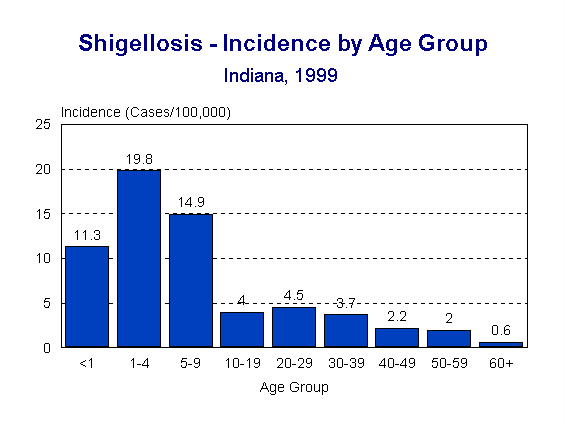
Shigellosis
Cases
= 368Crude rate
(per 100,000 population) = 6.6Age-adjusted race-specific rates
(per 100,000 population)White = 3.4
Nonwhite = 16.6
Gender-specific rates
(per 100,000 population)Female = 7.6
Male = 5.3
Shigellosis is a bacterial disease usually transmitted from person-to-person through hands contaminated with feces. It can also be transmitted through food and water contaminated with human feces, or through oral-anal sex practices. Shigellosis is highly communicable, as only 10-100 organisms must be ingested to establish an infection.
In 1999, 368 cases of shigellosis were reported in Indiana, representing a 130% increase from the previous year (Figure 1). This is the second consecutive year that the incidence of shigellosis infection has increased.
Figure 1.

There are four Shigella species, all of which infect only humans. The serotype was determined for 310 (84%) of the 368 reported shigellosis cases. Shigella sonnei accounted for 295 cases (95%), 13 were S. flexneri (4%), and 2 (1%) were S. boydii (Figure 2).
Figure 2.
Incidence of shigellosis peaked during the summer and early fall months (Figure 3). Females (7.6) were more likely to be reported than males (5.3). The age-adjusted rate of shigellosis was 4.9 times greater for nonwhites (16.6) than whites (3.4).
Figure 3.

Age-specific rates were highest among children aged 1 to 4 years (19.8), followed by children aged 5 to 9 years (14.9) (Figure 4). These high age-specific rates of shigellosis among preschool-aged and elementary school aged children represent the increasing problem of shigellosis outbreaks in day care centers and certain segments of elementary schools, primarily up through first graders.
Figure 4.

Among counties with at least 5 cases reported, the incidence rate was highest in St. Joseph (64.8), Fulton (37.2), Elkhart (24.3), Lake (13.3) and Hamilton (12.0) counties (Figure 5).
Figure 5.

Two outbreaks of shigellosis were reported in 1999. A community-wide outbreak of shigellosis occurred in St. Joseph County beginning in the spring and peaking during the summer and early fall months (Figure 6). The number of cases was highest in children aged 5 to 9, followed by children aged 1 to 4 (Figure 7). The majority of infections occurred in children attending daycare centers and their contacts.
Figure 6.

In September, the ISDH investigated a confirmed shigellosis outbreak in Steuben County among family members attending a dinner. Four cases were identified, and potato salad was the likely source of contamination. This outbreak is described in more detail in Appendix C.
[an error occurred while processing this directive]